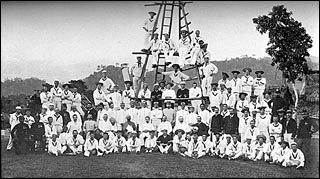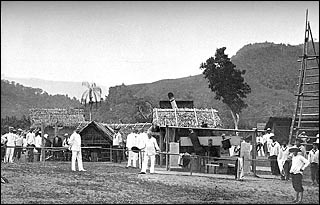|
Total Eclipse of the Sun, May 18, 1901 Reports on the Dutch Expedition to Karang Sago, Sumatra by Dr. A. A. Nijland, March 1903, Utrecht Published by the Eclipse Committee of the Royal Academy, Amsterdam The members of the expedition appointed by the Eclipse Committee, Messrs. Julius, Wilterdink and the writer started on their voyage about the beginning of March, Mr. Wilterdink travelling via Paris in order to look into the process of the silvering of glass mirrors at Gautier's shops, and to buy the necessary ingredients. The S.S. Koningin Regentes left Genoa on March 9. On board were several American and English astronomers, who also intended to observe the eclipse in Sumatra . . . The voyage was very pleasant, much attention being paid to various astronomical observations, the "green flash" at sunrise and sunset, Nova Persei, and the constellations of the southern hemisphere, Argo Navis, Crux, etc. At the last dinner on board, the day before our arrival in Padang, many hearty toasts were proposed, expressing best wishes for the success of the American, English, and Dutch expeditions.
Three days were spent, at Padang, in official calls and in buying several little necessaries. Finally, on April 10, Messrs. Muller, Wackers, Julius, Wilterdink, Hubrecht and the writer travelled to the camp on board the Condor , with the greater part of the instrument boxes, the other half having been transported, the day before, by Mr. Ohlenroth. The Condor made a trip through the beautiful bay of Taroesan and after a four hours delightful voyage, reached the roads of Karang Sago. A beacon had been erected at the point where we were to go ashore. Men and instruments were transported on little rafts made of native sampans (boats); the men were landed by means of a tandoe (sedan-chair); the instrument boxes up to the number of 60 were pikolled (carried on the shoulder) to the camp, a distance of 200 Meters. It was a curious sight, thirty or forty collies pikolling the big prismatic camera box, weighing no less than 300 K.G., by means of a huge and extremely complicated framework of bamboe . The day after our arrival in the camp the preliminary work was begun: the unpacking of the instruments (which appeared almost without exception to be in good condition), the surveying of the locality and the building of several (22) piers for the astronomical, physical, magnetical and meteorological instruments.
On April 23 the last pillar was ready; the greater number of the instruments was already in position, protected by huts or sheds of bamboe and atap . The long light-tight tube and hut for the 40-foot coronograph were only ready on April 30.
The adjustment of the instruments occupied the members of the expedition up to the last day. A heavy blow struck us . . . which happened to Mr. Wilterdink on May 3: while occupied with the writer with the adjustments of the 10-inch coronagraph, he fell from a wooden scaffolding and broke his right radius. Not only was the use of his hand strictly forbidden him, but he had to be transported to Padang for a few days, and though after his return he constantly assisted the other members with his advice, he was not able during the eclipse to take charge of one of the principal instruments. Under direction of Messrs. Muller, Julius and the writer thirty practice drills were held from May 12 to 17; some of them in the evening in order to be used to lamplight for the reading of chronometer faces, scales, etc., in case the eclipse should prove to be a very dark one. The observers of shadow bands and further phenomena, and the corona sketchers practiced apart. A corona drawing, varied from day to day, was hung up at the height (70°) of the eclipsed sun; and was drawn by 8 men, each being only responsible for one quadrant: as Mr. Balsem undertook to draw the whole of it, the result should be 3 complete sketches. For full details I refer to the special reports. Here I shall only mention the general mode of proceeding. 5m before totality: every man at his post and ready. 81s before totality: The word " klaar " (ready) given by Mr. Wackers, who states, on the ground glass of the 10-inch coronagraph, that the sun's crescent covers an arc of 90°. 40s later. Timekeeper A calls out " spiegels " (mirrors); the three assistants take the caps off the mirrors, their task being further to pay attention to the siderostats in order that no unexpected impediments might occur. 15s or 16s before totality. Call " opgepast " (attention) either by Mr. Muller, when the sun's crescent is seen to cover an arc of 45°, or by the lookout, when the searchlight of the pigmy is screened off. The call " opgepast " is to be repeated, in either case, by timekeeper A. Beginning of totality, as observed by Mr. Muller in the dark hut of the 40-foot lens. Call: " los " (go). Timekeeper B begins the counting of seconds: nul, een, twee . . . A tries to estimate the interval between "los" and "nul" and notes the chronometer reading corresponding to the count ten. Timekeeper B goes on counting up to 200 and is relieved by A: thus the 200th second is counted by both A and B. In case no sun is visible at the beginning of totality, " nul " is called out at 12h 19m 51s local civil time. 380s after the beginning of totality, or, in case the 2nd contact is lost, at 12h 26m 11s: call " sluiten " (shut) by timekeeper B. End of totality. Call " over " by Mr. Muller; timekeeper A goes on counting till Mr. Muller emerges from the dark hut and notes the chronometer reading. On May 18, at day-break the sky was wholly overcast. Bye and bye the clouds grew thinner and at 11 o'clock the weather was nearly perfect. Then altocumuli began to gather and the eclipse has unfortunately been observed through a rather thick veil of clouds. During totality the blue of the sky was very pale and greyish; the scenery was illuminated by the well-known dull, gloomy, ghastly eclipse light. The clouds at 50° West of the eclipsed sun looked fallow or had a dingy orange tint. And round the inky black moon the double fishtail of the brilliant silvery corona was visible through the gaps in the cirrusclouds: a most glorious sight, never to be forgotten. No noise was heard, the Malay population having been warned by Mr. Van Loghem . . . to keep quiet and not to hinder the observations by screaming, as they were likely to do. Kalongs (great bats) are said to have left their hiding places, as if it were night. The curious "chromatic bird" we heard every evening in the camp, sang out of tune! On the native population of the camp the eclipse evidently did not make a very strong impression: when I asked my Malay servant what he thought of the grahana matahari he simply answered: gelap (dark). Immediately after the eclipse it was known that the spectroscope, the photometer and the small spectrograph had given no results. It was to be feared, of course, that the clouds would also have spoiled the greater part of the other observations and photographs.
Immediately after the eclipse, the photographer Mr. Nieuwenhuys set to work
to develop the plates, using many kilograms of ice. The last plate
was developed on May 22; it appeared, that also the exposure with
the large spectrograph was an entire failure.
|
||||||||||||||||||||||||

|

|

|




